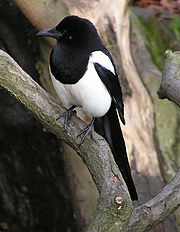
Magpie
About this schools Wikipedia selection
SOS Children volunteers helped choose articles and made other curriculum material A quick link for child sponsorship is http://www.sponsor-a-child.org.uk/
| Magpie | |
|---|---|
 |
|
| European Magpie | |
| Scientific classification | |
| Kingdom: | Animalia |
| Phylum: | Chordata |
| Class: | Aves |
| Order: | Passeriformes |
| Family: | Corvidae |
| Genera | |
|
|
Magpies are passerine birds of the crow family, Corvidae. The names ' jay' and 'magpie' are to a certain extent interchangeable, although this does not accurately reflect the evolutionary relationship between these birds. For example, the Eurasian Magpie seems more closely related to the Eurasian Jay than to the Oriental Blue and Green Magpies, whereas the Blue Jay is not closely related to either.
In Europe, "magpie" is often used by English speakers as a synonym for the European magpie, as there are no other magpies in Europe outside Iberia.
Magpies are known to steal other young birds, commonly young chickens, away from their nests.
The bird was referred to as a pie until the late 16th century when the feminine name Mag was added to the beginning.
Systematics and species
According to Ericson et al. (2005), magpies do not form the monophyletic group they are traditionally believed to be; a long tail has certainly evolved (or shortened) independently in multiple lineages of corvid birds. Among the traditional magpies, there appear to be two evolutionary lineages: One consists of Holarctic species with black/white coloration and is probably closely related to crows and Eurasian jays. The other contains several species from South to East Asia with vivid coloration which is predominantly green or blue. The Azure-winged Magpie is a species with a most peculiar distribution and unclear relationships. It may be the single survivor of a long extinct group of corvid genera.
Other recent research (Lee et al., 2003) has cast doubt on the taxonomy of the Pica magpies, since it appears that P. hudsonia and P. nuttalli may not be different species, whereas the Korean race of P. pica is genetically very distinct from the other Eurasian (and even the North American) forms. Either the North American, Korean, and remaining Eurasian forms are accepted as 3 or 4 separate species, or there exists only a single species, Pica pica.
Holarctic (black-and-white) magpies
- Genus Pica
- European Magpie, Pica pica
- Black-billed Magpie, Pica hudsonia (may be conspecific with P. pica)
- Yellow-billed Magpie, Pica nuttalli (may be conspecific with P. pica/P. hudsonia)
- Korean Magpie, Pica sericea (may be conspecific with P. pica)
Oriental (blue/green) magpies
- Genus Urocissa
- Formosan Blue Magpie Urocissa caerulea
- Red-billed Blue Magpie, Urocissa erythrorhyncha
- Gold-billed Magpie, Urocissa flavirostris
- White-winged Magpie, Urocissa whiteheadi
- Sri Lanka Blue Magpie, Urocissa ornata
- Genus Cissa
- Green Magpie, Cissa chinensis
- Yellow-breasted Magpie, Cissa hypoleuca
- Short-tailed Magpie, Cissa thalassina
Azure-winged Magpie
- Genus Cyanopica
- Azure-winged Magpie, Cyanopica cyana
Other magpies
The Black Magpie, Platysmurus leucopterus, despite its name, is neither a magpie nor, as was long believed, a jay, but a treepie. Treepies are a distinct group of corvids externally similar to magpies.
The Australian Magpie, Gymnorhina tibicen, is conspicuously piebald, with black and white plumage reminiscent of a European Magpie, but it is not a corvid.
Diet
Magpies eat mostly worms, slugs and small insects. They feed their young the same. Magpies can be seen scratching into the ground, looking for food, such as spiders and worms. Magpies hunt day and night. Magpies aren't exclusively carnivores or herbivores, but they are more carnivores than herbivores. Magpies learn to find food for themselves when they are very young.
Magpie in culture
Most English language cultural references to magpies are those for the European Magpie, since the word "magpie" usually refers to that species. Magpies are symbols of good luck in China and Korea, in contrast with their relatives the crows, which are portents of bad omens. In Britain and Ireland, magpies may represent good or bad luck of various forms in a complex manner, depending on the number of magpies present, according to various traditional rhymes starting "One for sorrow, two for joy,..." or "One for sorrow, two for mirth,...".

